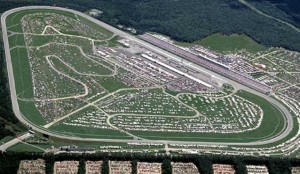A Brief History of the Pocono Raceway
For NASCAR fans, summertime means it’s time to load up some camping gear and head to the Poconos. The home of a pair of NASCAR Sprint Cup Series races held in June and August—the Pocono 400 and the GoBowling.com 400 respectively—the Pocono Raceway is one the most storied tracks in NASCAR history. Also home to the Pocono Indycar 500 and used by Sports Car Club of America along with motorcycle clubs and driving schools, the track gets a lot of use throughout the year.
The track is famous for its shape. Often described as a tri-oval, the track is actually closer to a triangle than an oval. It is unique in that its three turns are all different and modeled after turns from other tracks. Turn One has 14 degree banking and was based on the turns at the old Trenton Speedway. Turn Two, which has 9 degree banking and is also known as “The Tunnel Turn,” is similar to the Indianapolis Motor Speedway, while the 6 degree banking of turn 3 is based on The Milwaukee Mile.
But though NASCAR wouldn’t be the same without it today, there was a time when the Pocono Raceway nearly closed down for good. The raceway held its first race in 1968 on the three-quarter mile track. Three years later, the first 500 mile Indy race came to the Poconos on the two and a half mile rack and the first 500 mile NASCAR race at Pocono Raceway was held in 1974. But just as Pocono Raceway was getting its NASCAR start, the owners of the track, the Mattioli family were having some financial problems.
As they tell it, due to some inexperience and construction mistakes, they were on the verge of bankruptcy and close to selling the track. Then came a telephone call from Bill France, Sr., a NASCAR cofounder. He invited the family to New York for a meeting. There, he tried to convince the family that the right course of action would be to hang on through their tough times and keep control of Pocono Raceway.
They remained unsure, and that’s when France took out one of his business cards and wrote on the back: “On the plains of hesitation lie the bleached bones of millions who were within the grasp of victory, sat and waited—and waiting died.” It was enough to convince the family not to sell. France showed his support by giving Pocono Raceway another NASCAR race.
This didn’t solve all of the raceways problems however. The track had a lot of construction errors and the Mattiolis decided something needed to be done about it. They needed a lot more done than just repainting some lines on the asphalt though. Twenty-five years after the track was first built, they started to start over from scratch. Using their knowledge of what worked and what didn’t after so many years in the business, they completely restructured the course over a ten year period.
They repaved everything, added new crash walls and replaced the old garages. For the fans, they built a massive “Paddock Area” that let onlookers get 56 feet away from the action. More importantly they added the biggest bathroom in the world, called the Long John. With 1000 stalls, no one ever has to wait in line.
Though it has a long history, Pocono Raceway is very much leading other tracks into the future. Since 2010, it has been powered exclusively by solar power, making it the biggest solar-powered sports facility. It’s forward thinking innovations like this that will ensure Pocono Raceway will never again face the problems it has in the past and will be around to host many more races.
Check out Scott Huntington’s new auto-blog, offthethrottle.com

, Tylenol) are not impacted by this specific action. Although topical creams can relieve spme pain they don’t worek on the whole body and can be ineffective over long periods of time.
Percocet has the narcotic oxycodone and non narcotic Tylenol together in pill form.
Here iss mmy page … oxycodone vs. Hydrocodone better high
This piece of writing offers clear idea in favor of the new people of blogging, that
actually how to do blogging and site-building.
Juicing advocates also highlight this benefit when they promote
the practice and encpurage friends and co-workers to engage in juicing as well.
Because it is filling, it is more difficult to consume as many nutrients as you are receiving from
juicing. It can bbe a beneficial part of your weight
loss plan as well.
My weblog :: juicing detoxing and fasting for life
https://www.youtube.com/watch?v=LG8lM-P2mzM
Hi, i think that i noticed you visited my weblog so i got here to go back the
desire?.I’m trying to to find issues to enhance my site!I suppose its good enough to make use of some of your
ideas!!
Well post and i read your history detail and its give me good info thanks for sharing .
Well post and i also read your history detail and it is produce good info appreciate your sharing .
Great work. Very appreciable. Good Luck.
This piece was both helpful and transformative.
Asphalt contracto rhttps://www.duncanfoulkespr.com/blog/award-finalist-ciara-paving-the-way-in-civil-engineering
rocklin se ohttps://megalocallistings.com/marketing-agency/social-cali-marketing-company-rocklin-ca/